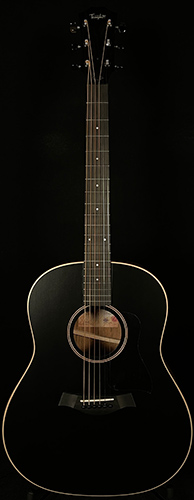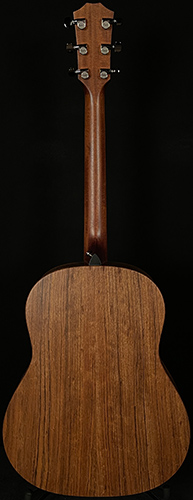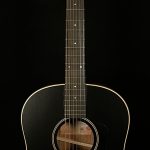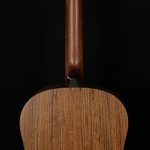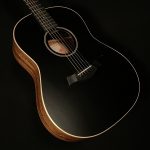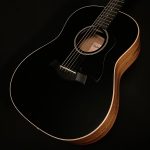Taylor Guitars American Dream Grand Pacific AD17 Blacktop
Born in the USA
Wildwoodians, we are proud to present the Taylor American Dream series, a line of solid-wood, American-made Taylor guitars that deliver a metric ton of tone and supreme Taylor playability at a player-friendly price point. "American Dream" is a fitting name for this line for a variety of reasons. First, because they make the magic of a solid-wood Taylor more accessible to more players, as they offer a premium playing experience at an exceptional value. Second, because Bob Taylor started Taylor Guitars in a shop called American Dream in 1974, and these guitars live up to the pedigree of excellence, innovation, and craftsmanship that Bob Taylor has established ever since. Finally (and most importantly), because the story of the American Dream series is one of great trailblazers achieving at the highest possible level during times of great adversity, and there is nothing more American than that.What's the Story, Morning Glory?
You see, like most Americans, Bob Taylor and Andy Powers started to get a little restless and anxious while they were quarantined because of the COVID-19 virus. When the world is in a state of upheaval, it's only natural to turn to what you know best for comfort, so Bob and Andy decided to hunker down in the workshop and embark on a new creative project. They challenged themselves to build the most affordable solid-wood Taylors possible, which proved to be quite an undertaking. Since most of the world had shut down, they had to cook with whatever ingredients they had in the kitchen.As is often the case with creative endeavors, the limitations presented by their situation compelled them to think outside the box and come up with something fresh, new, and exciting. Bob and Andy decided to use woods with lots of cosmetic character and interesting grain patterns that suit the workmanlike attitude of the American Dream series, and as a result, each guitar has a striking individual personality.
Their limitations also pushed them to find new tonewoods. For instance, they used fumed eucalyptus for the fingerboard and bridge. Eucalyptus is an uncommon tonewood, but it is quite similar to ebony in density and tonality, and its sustainability is off the charts. As an added bonus, the fuming process (which enhances stability) gives it a beautiful, earthy dark brown color. Thanks to Bob and Andy's ingenuity, they introduced the guitar world at large to a spectacular new tonewood!
Ovangkol Me Maybe
But, the main ingredients in the AD17's sonic cocktail are its spruce top and ovangkol back and sides. Spruce has been a go-to for acoustic guitar manufacturers for years, and for good reason. Guitars with spruce soundboards sound full-bodied yet balanced and have superb articulation. This tone works beautifully with the sound of ovangkol, an African relative of rosewood with many inspiring sonic properties a visually striking appearance. It sounds somewhat similar to its South American cousin, but with a few key differences. It has the deep, rich, piano-like bass response of rosewood, but its high-end has the sweetness and sparkle of koa, and its midrange response is fuller and warmer. Also, it is less dense than rosewood. This means it has fewer clashing overtones and better clarity and note separation. Best of all, it is one of the most sustainable tonewoods out there!Together, ovangkol and spruce give the AD17 a well-rounded, balanced tone suitable for a wide variety of musical applications. They work especially well in the context of Taylor's Grand Pacific body shape. So, let's dive deeper and examine the greatness of the Grand Pacific!
The Grand Pacific: A Modern Classic
Wildwoodians, we are proud to present the latest guitar to emerge from Taylor design maestro Andy Powers's workshop: the Grand Pacific dreadnought. Simply put, this new round-shouldered beast is one of the most inspiring new guitar designs to emerge in the last decade. Though many of Taylor's classic cornerstones inform its design, the Grand Pacific sounds and feels like nothing else in their entire line. It's revolutionary, it's bold, it's fresh, it's imaginative, and above all, it is sure to inspire you to reach new heights on your journeys across the fretboard. I (Trevor, the resident Wildwood Guitar Scribe) would like to cordially invite you to journey down the rabbit hole with me and learn a bit more about what makes the Grand Pacific so spectacular.California Dreamin'
I was lucky enough to learn about the Grand Pacific straight from the source, because our friends at Taylor were kind enough to fly me out to San Diego to visit their factory in El Cajon and learn about the Grand Pacific from Andy Powers himself.Andy Powers is everything you'd hope him to be. He brims with warmth and intelligence, and he is a truly fearsome guitar picker. After setting the fretboard ablaze as he put a Grand Pacific through its paces, he shed some light on what inspired him to build the guitar in the first place.
While Andy was doing a bunch of work on his new home, he found himself listening to a lot of classic acoustic music: bluegrass, country, and folk. Now, Andy was a renowned repairman before he started work at Taylor. Though he's too modest to name names, he personally worked on many historic guitars that made appearances on iconic records. As he listened to these albums, he reflected on the time he spent with these classic instruments. Oddly enough, many of them left him wanting something more when he sat down with them. They just didn't sound like the record! Why? The wheels in Andy's head started turning, and he started dreaming. How could he design an acoustic guitar that sounded like a record in the room? The seed that would grow into the Grand Pacific began to sprout.
The Birth of V-Class
To tell the story of the Grand Pacific, we have to pick up the story of V-Class bracing. Though V-Class bracing made its commercial debut in Taylor's Grand Auditorium guitars, Andy Powers actually came up with the idea for the Grand Pacific. V-Class bracing is truly revolutionary, and it is one of the reasons for the Grand Pacific's greatness.You see, for years acoustic guitar builders had to compromise between volume and sustain. Flexibility equals volume, and stiffness equals sustain. Obviously, a piece of wood cannot be rigid and flexible at the same time, so builders had to go for one or the other.
Andy Powers wanted to have his cake and eat it, too. After much tinkering, V-Class bracing was his elegant solution to the problem that has plagued luthiers for centuries. As the name implies, V-Class bracing features two long pieces of wood that make a "V" shape together. The bracing is quite thin and flexible near the rear bout, but it becomes thicker as you get closer to the soundhole.
So, you get volume from the flexible parts of the bracing, and sustain from the rigid parts! Many areas of the guitar neck that typically sound weak (ninth fret on the G string, for instance) have just as much presence, resonance, and sustain as the low E. As a result, the Grand Pacific AD17 Blacktop sounds supremely balanced.
Intonation Station
V-Class bracing also does wonders for the guitar's intonation. Are you ready to have your mind blown? When I was in El Cajon, Andy explained that an acoustic guitar's intonation is not necessarily just the sum of the typical adjustments like saddle height, nut slots, and neck angle (though they do play a part). The way that the actual guitar itself vibrates also has a lot to do with how in-tune it sounds.Andy told me to picture it like this: when you take close-up slow-motion footage of a guitar's top with a high-speed camera as someone plays it, you can see the top move vividly. On a traditional X-braced guitar, the top vibrates in a disorderly, disjointed manner. This can cause a guitar with the perfect saddle height and neck angle to sound out of tune when you play a big open chord.
By contrast, guitars with V-Class bracing vibrate in a much more orderly manner. The graduated braces compel the energy from the player's attack to move from the thin outer part of the bracing to the thicker inner part in an efficient manner. If you were to take a high-speed shot of a V-Class top, you would see it rock back and forth evenly. Because of that V-Class magic, the Grand Pacific AD17 Blacktop sounds so in-tune that it's scary.
A Metaphor for Monster Sound
So, how does V-Class bracing sound in the context of a classic dreadnought? Andy loves to talk in metaphors, and he shared one really crystallized my understanding of the Grand Pacific's tone. Imagine a six-lane highway with six cars traveling side-by-side in their respective lanes. That's how a Grand Auditorium with V-Class bracing sounds. You can hear each note ring out pure and clear with excellent separation.The Grand Pacific's response is more like six boats traveling side by side. Though the boats don't crash into one another, their wakes interact behind them. When you strum all six strings on a Grand Pacific, the notes "run together" and blend in a way that is symmetrical and orderly but also warm and inviting. Andy kept calling it a "seasoned" sound, and that's an apt description. The notes bleed into one another and form beautiful vivid, colorful timbres.
Post-Production Magic
The reason why most of the iconic guitars Andy repaired left him feeling disappointed is simple: a lot usually happens to acoustic tracks in post-production. Typically, a mixing engineer will use an EQ to roll off woofy low end and cut other "problem frequencies" that sound ugly. They'll then use a compressor to round off the attack, and a limiter to kill any remaining transients. So, that guitar that sounded gloriously rich in the room during the recording winds up sounded sculpted and well-mannered on the actual record. Thanks to its V-Class bracing, the Grand Pacific AD17 Blacktop sounds like much of this post-production work is already done as you play it live in the room.Here's the best way to explain it, again courtesy of the illustrious Mr. Powers. Put an open palm in front of your mouth and say "PUH PUH PUH PUH PUH" repeatedly (don't do this in public or you will look foolish). Then say "MM MM MM MM MM" into your palm. Typical dreadnoughts make that "PUH" noise upon attack as woofy low-end escapes the soundhole. The Grand Pacific makes more of a "MM" sound. It may not rattle your rattle your ribs, but it does sound awfully nice—iconic, even.
Therein lies both the rub and the magic with the Grand Pacific: though it has plenty of muscle and power, it doesn't necessarily sound like a wooden piano in the room. It sounds produced, and there's a big difference. For that reason, it's not going to replace your J-45 or your D-18. Big-sounding, boomy acoustics are a lot of fun, and we love them, too. The Grand Pacific AD17 Blacktop just presents a whole new flavor of acoustic tone that is different but equally enticing. Playing one feels like stepping into a classic record that hasn’t been made yet.
Add it Up
So, what does it all add up to, sonically? The Grand Pacific sounds warm, seasoned, and inviting like a classic dreadnought as warm overtones swirl together and mix to form a truly spectacular collage of sound. But, V-Class bracing also gives it a spectacular combination of volume and sustain. Furthermore, V-Class bracing helps sculpt the Grand Pacific’s frequency response to sound balanced and mannered. Not to mention, it helps give the Grand Pacific astoundingly accurate intonation. So, to sum things up: the Grand Pacific AD17 Blacktop is a warm, vintage-style dreadnought with improved volume, sustain, balance, and intonation. I don’t know about you, but I’ll trade a little bass boom for all that any day of the week!Runnin' Down an American Dream
Wildwoodians, we are proud to present the Grand Pacific AD17 Blacktop, a marvelous example of American ingenuity in the face of a global crisis. With nothing but limited resources and the endless hours of quarantine, Andy Powers and Bob Taylor have built yet another American classic: a workhorse dreadnought that delivers an absolutely magical playing experience at a player-friendly price. These guitars have superior resonance thanks to their solid-wood construction, and they have incredible playability and build quality thanks to the meticulous craftsmanship of the fine men and women at Taylor's facility in El Cajon, California. We invite you to take one of these beauties for a spin so you can start runnin' down your own American Dream!Specifications:
| Brand | Taylor Guitars |
|---|
| Model | Grand Pacific AD17 Blacktop |
|---|---|
| Body Type | Grand Pacific |
| Top Wood | Solid Spruce |
| Top Finish | Satin Black |
| Bracing | V-Class |
| Back & Sides Wood | Solid Ovangkol |
| Back & Sides Finish | Satin Natural |
| Neck Wood | Rustic Neo-Tropical Mahogany |
| Neck Dimensions | .840 1st - 870 9th |
| Fretboard Material | Fumed Eucalyptus |
| Fingerboard Inlays | 4mm Italian Acrylic Dots |
| Scale Length | 25.5" |
| Width at Nut | 1 3/4" |
| Nut Material | Black Graphite-Infused Tusq |
| Binding | None, Chamfered Edges |
| Purfling | Black |
| Rosette | Single-Ring Black/Maple/Black |
| Tuners | Taylor Nickel |
| Bridge | Fumed Eucalyptus |
| Saddle | Micarta |
| Case | Aerocase |
| UPC | 00887766106876 |
Why Order from Wildwood Guitars?
An instrument from Wildwood isn't just an ordinary guitar. It's your guitar. Each and every instrument we sell includes a full, point by point setup, an exhaustive evaluation, and expert shipping procedures, with first class, industry leading standards from start to finish. Why? Because you deserve it.Click Here to learn more about what makes a Wildwood instrument so special...


